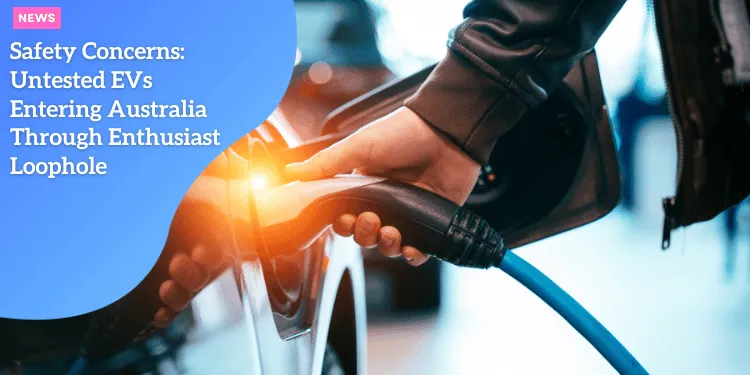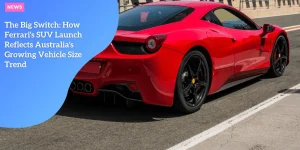Safety Concerns: Untested EVs Entering Australia Through Enthusiast Loophole

Anúncios
Overview of the Specialist and Enthusiast Car Scheme
The specialist and enthusiast car scheme was originally designed with a very specific purpose in mind.
It aimed to allow car enthusiasts to import unique, historical, or high-performance vehicles into Australia.
This included classic American hot rods, rare sports cars, and other vehicles that cater to niche interests and collector desires.
However, the good intention behind this scheme seems to be swaying from its core purpose.
Original Intention vs. Current Misuse for Importing EVs
Over time, this scheme has been increasingly utilized for importing electric vehicles (EVs), especially second-hand ones.
This was never the intended use of the scheme, and as a result, numerous untested and potentially unsafe EVs are now entering the market.
The Australasian New Car Assessment Program (ANCAP) has voiced strong concerns about this shift in use.
According to ANCAP Chief Executive Carla Hoorweg, the scheme is being “misused” to import potentially dangerous second-hand electric vehicles into the country.
The regulatory framework originally designed to facilitate the import of specialist and enthusiast vehicles is now being bypassed to bring in a larger quantity of untested EVs.
This misuse has prompted serious safety concerns that cannot be ignored.
Concerns Raised by ANCAP About Untested Vehicles
ANCAP’s main issue with this loophole is the lack of proper safety testing for these imported EVs.
The organization’s rigorous testing procedures require multiple vehicles of the same model to generate a comprehensive safety rating.
Due to the nature of the specialist and enthusiast scheme, only individual or small batches of vehicles are imported, making them ineligible for the full spectrum of ANCAP’s tests.
Hoorweg indicated that this loophole essentially subverts ANCAP’s rating system and Australian design rule requirements.
This creates a scenario where older and less safe vehicles can circumvent established safety protocols, leading to potential risks for Australian consumers.
As we move forward, understanding these safety implications and addressing them is crucial for ensuring consumer safety and maintaining the integrity of the vehicle importation process in Australia.
Safety Implications of Untested EVs
Lack of Proper Safety Testing for Imported EVs
Untested electric vehicles (EVs) making their way into Australia via the enthusiast vehicle loophole pose a significant safety risk.
This scheme allows individuals or small batches of vehicles to be imported without undergoing the stringent safety tests mandated for conventional imports.
As a result, these vehicles often bypass comprehensive safety evaluations, raising serious concerns about their roadworthiness.
Risks Associated with Bypassing ANCAP’s Rating System
The Australian New Car Assessment Program (ANCAP) relies on a rigorous testing process to ensure vehicle safety.
However, because the enthusiast scheme permits the import of individual vehicles or small groups, these vehicles escape ANCAP’s systematic crash-testing protocols.
The program, requiring at least four identical models for a complete assessment, cannot rate these one-off imports, essentially circumventing Australia’s established safety standards.
Potential Dangers of Older, Unsafe Vehicles Entering the Market
Moreover, many of the EVs imported through this loophole are second-hand, older models that might not meet contemporary safety benchmarks.
Unlike newer vehicles, these older models are more prone to safety deficiencies, making them potentially hazardous.
By bypassing safety assessments, there’s a risk of these unsafe vehicles causing accidents or endangering driver and passenger lives.
As the focus shifts to outlining ANCAP’s testing challenges, it becomes evident why strict adherence to car safety evaluations is critical.
ANCAP’s Testing Process and Challenges
Rigorous Testing Procedures
The Australasian New Car Assessment Program (ANCAP) is known for its stringent and thorough testing procedures.
To ensure consumer safety, ANCAP meticulously evaluates vehicles across various crash scenarios, including head-on collisions and side-impact crashes.
These examinations help gauge how well a vehicle protects its occupants and contributes to the overall star safety rating.
Remarkably, this rigorous testing demands the destruction of four identical production models.
This requirement ensures that results are comprehensive and reliable, covering multiple aspects of a vehicle’s structure and safety features.
Multiple Vehicles for Comprehensive Testing
One of the biggest hurdles ANCAP faces is the necessity of using multiple vehicles for complete testing.
By dismantling and crashing four vehicles, the organization can scrutinize different critical areas under various conditions.
This multi-car requirement underpins why existing safety ratings are so trustworthy.
However, it becomes a significant limitation when dealing with individually imported vehicles.
Without a fleet of identical models, it’s impossible to perform the array of tests needed for a robust safety evaluation.
Limitations in Testing Individually Imported Vehicles
Introducing EVs through the specialist and enthusiast car scheme presents unique challenges.
Given the program’s allowance for importing individual or small batches of vehicles, ANCAP can’t ensure these EVs undergo the essential safety checks.
Essentially, this approach bypasses the established evaluation framework, allowing potentially unsafe vehicles to enter the market unchecked.
With no mandate for multiple vehicles to conduct proper testing, significant safety risks remain, putting consumers at risk.
The intricacies and limitations of ANCAP’s testing processes underscore the need for rigorous vehicle safety measures, ensuring no bypassing of industry norms.
EV Safety Misconceptions and Reality
Addressing Misinformation about EV Safety
Electric vehicles (EVs) have garnered significant attention, and not all of it is positive.
Misconceptions about the safety of EVs, particularly those imported through the enthusiast vehicle loophole, abound.
To set the record straight, ANCAP has been thorough in its pursuit of transparent and accurate safety assessments for electric cars.
This chapter demystifies the topic by focusing on ANCAP’s findings and the real-world performance of EVs and hybrid vehicles.
ANCAP’s Findings on EV and Hybrid Vehicle Performance
ANCAP has tested and rated over 90 EVs and hybrids, offering an extensive database of safety performance.
Contrary to certain misleading claims, these vehicles have demonstrated safety ratings comparable to traditional internal combustion engine cars.
Many EVs achieved ratings of four or five stars, indicating robust safety profiles consistent with those of conventional vehicles.
Lack of Battery-Related Incidents in Testing
One area of concern often highlighted is the potential for battery fires; however, ANCAP’s rigorous testing has not substantiated these fears.
During extensive evaluations, ANCAP has not recorded any incidents of battery-related fires.
This stands as a testament to the inherent safety in the battery systems of most modern EVs.
The testing procedures are meticulous and intrusive, designed to assess aspects like battery integrity under various stress conditions.
Despite these rigorous tests, EVs have shown remarkable resilience, further debunking widespread misinformation about their safety.
As we move forward, maintaining reliable safety standards for all vehicles, including those imported under specialized schemes, remains crucial to consumer trust.
This foundation of trust is essential as we adapt regulations to mainstream the adoption of EVs.
Regulatory Oversight and Data Transparency
Role of the Department of Infrastructure and Transport
The Department of Infrastructure and Transport plays a crucial role in overseeing the specialist and enthusiast car scheme.
Originally, this scheme was designed to allow the import of unique, historical, or high-performance vehicles.
However, its current misuse for importing second-hand EVs has caught the attention of ANCAP and various stakeholders.
The department now finds itself at the center of a growing safety concern, tasked with regulating vehicles that bypass essential safety tests.
This loophole not only undermines ANCAP’s rigorous testing protocol but also poses real risks to public safety.
Lack of Public Data on Imported EVs
One of the pressing issues is the lack of transparency regarding the number of EVs imported through this scheme. ANCAP’s CEO, Carla Hoorweg, has pointed out that this data isn’t readily available to the public, though it is likely held by the Department of Infrastructure and Transport
. The absence of accessible data hinders the ability to fully assess the scope of the problem and to implement necessary safeguards.
This lack of transparency creates a blind spot for both regulators and consumers, making it difficult to ensure that all imported vehicles meet stringent safety criteria.
Call for Review of the Specialist and Enthusiast Scheme
Given the significant misuse of the scheme, there is a growing call for its review.
As Carla Hoorweg emphasized, the scheme’s original intention was not to allow for the widespread importation of second-hand EVs.
The entry of older, potentially unsafe vehicles into the market warrants a comprehensive review to update and tighten regulations. Re-evaluating the scheme could include:
- Revising criteria to ensure only genuinely unique or historical vehicles are eligible.
- Strengthening oversight mechanisms to prevent misuse.
- Requiring that all imported EVs undergo ANCAP’s safety testing before being approved.
These steps are essential to restore the integrity of the scheme and protect Australian consumers from potential safety hazards.
The role of adequate regulatory oversight and data transparency cannot be overstated.
Addressing these issues is pivotal in ensuring that Australia’s transition to electric vehicles is both safe and efficient.
Future Considerations and Industry Response
Adapting Regulations for Mainstream EV Adoption
Given the increasing misuse of the specialist and enthusiast car scheme to import second-hand EVs, there’s a pressing need to adapt regulations to facilitate mainstream EV adoption.
Originally designed to allow the importation of unique and historic cars, the scheme is now being exploited to sidestep necessary safety evaluations.
Updating regulatory criteria is crucial to ensure that all imported EVs are subject to comprehensive safety testing and meet the same rigorous standards as locally sold vehicles.
This will help protect consumers and maintain the integrity of the market.
EV Charging Infrastructure Development
As the adoption of EVs grows, so does the need for a robust charging infrastructure.
Significant strides are being made to build a network of charging stations across the country.
BP, for example, has already installed 140 charging stations through its EV charging arm, BP Pulse.
The company is investing in high-capital equipment and expanding power capacity to meet increasing demand.
This development not only facilitates convenient access to charging but also helps in mainstreaming EV adoption by addressing potential range anxiety issues.
Balancing Traditional Energy Business with EV Growth
The transition to EVs presents an interesting challenge for energy companies traditionally focused on fossil fuels.
BP’s involvement in EV charging networks highlights this complex scenario.
The company aims to be a net-zero entity by 2050, despite making record profits from oil and gas.
This dual focus requires careful navigation to balance existing profit-driven oil and gas operations with sustainable initiatives like EV charging.
The industry’s response to this challenge will significantly impact the pace and success of the EV market’s growth.
With these considerations in mind, the industry is at a pivotal point.
Striking the right balance between traditional and emerging energy needs while ensuring that regulatory frameworks evolve to support safe and transparent EV adoption is essential for the future.






